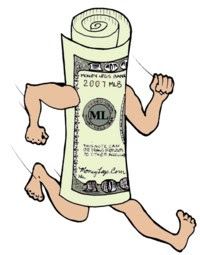Rising prices feature in many economic forecasts for the US. It is seen as part of the reflation meme as the vaccines roll out. There seem to be three threads to the discussion. The first is practically mathematically certain. Economists refer to it as the base effect. As the pandemic struck and the economy shut down, prices fell. Headline CPI fell by 0.4% in March 2019, by 0.8% in April, and another 0.1% in May. The PCE deflator, which the Fed targets, fell by 0.3% in March and by 0.5% in April. It rose by 0.2% in May. The point is the negative prints will drop out of the year-over-year comparisons, and barring a new sharp economic downturn, they will be replaced by higher numbers. This will be reflected in an increase in the year-over-year rate and
Topics:
Marc Chandler considers the following as important: 4.) Marc to Market, 4) FX Trends, newsletter
This could be interesting, too:
Nachrichten Ticker - www.finanzen.ch writes Die Performance der Kryptowährungen in KW 9: Das hat sich bei Bitcoin, Ether & Co. getan
Nachrichten Ticker - www.finanzen.ch writes Wer verbirgt sich hinter der Ethereum-Technologie?
Martin Hartmann writes Eine Analyse nach den Lehren von Milton Friedman
Marc Chandler writes March 2025 Monthly
Rising prices feature in many economic forecasts for the US. It is seen as part of the reflation meme as the vaccines roll out. There seem to be three threads to the discussion.
The first is practically mathematically certain. Economists refer to it as the base effect. As the pandemic struck and the economy shut down, prices fell. Headline CPI fell by 0.4% in March 2019, by 0.8% in April, and another 0.1% in May. The PCE deflator, which the Fed targets, fell by 0.3% in March and by 0.5% in April. It rose by 0.2% in May.
The point is the negative prints will drop out of the year-over-year comparisons, and barring a new sharp economic downturn, they will be replaced by higher numbers. This will be reflected in an increase in the year-over-year rate and provide the grist for an inflation scare. In the four months through November, headline CPI has risen by an average of 0.2% a month. The PCE deflator has risen by about 0.1%, on average, over the same period.
What the base effect gives it can take away. Headline CPI increased by 0.6% in June and again in July before rising 0.4% in August. The core rate rose by 0.2% in June, accelerated to 0.6% in July, and rose by 0.4% in August. The forces that lift measured inflation in spring ease in the summer and return in Q4 2021. The headline and core PCE deflator were flat in October and November.
The second thread is that the kindling for inflation exists and will likely ignite in the period ahead. Economists seem to differ over the exact nature of the kindling. Some still insist that the creation of reserves with which the central banks buy assets is inherently inflationary, even though before the pandemic, the Federal Reserve, most European central banks, and the Bank of Japan were having grave difficulty in achieving their inflation targets. Moreover, although US nominal rates have not fallen below zero (like Europe and Japan), its real rates (nominal minus inflation/inflation expectations) are negative and more so than in Europe and Japan.
Others insist that rising commodity prices, from copper and iron ore to soybeans and lumber, have trended higher. Rising demand in Asia, especially China, has given rise to many industrial commodities. Strong housing activity and home improvements in the US, coupled with bottlenecks at the millers, have seen lumber prices soar. The CRB Index is up nearly 62% off the April lows, but that is a bit of cherry-picking. After all, it is off around 12% from a year ago. The role of commodity prices plays a small role in the production of many goods. The idea that it represents "pipeline" inflation seems a bit dated, though it could impact profit margins in some sectors. Moreover, American consumers spend more on services than goods, and the CPI and PCE baskets reflect this.
The dollar has fallen against all the major currencies this year and many emerging market currencies. A weaker dollar is often associated with rising commodity prices, most of which continue to be quoted and traded in dollars. Many, including ourselves, expect the dollar to trend lower next year. To be sure, dollar depreciation may pose an obstacle to other central banks trying to reflate.
Some observers are concerned about the pent-up demand that will be unleashed when herd immunity is achieved through the disease and vaccinations. In the face of increased demand, they worry about the constrained supply, given the number of small businesses that will not survive. The new scarcity will be distributed by higher prices, so goes the argument. Supply may be more elastic than assumed.
The Federal Reserve signaled its willingness to accept higher inflation by adopting an average inflation target. The ECB will conclude its strategic review, and two concrete measures are likely. The first is to modify its current inflation target to 2%, rather than "close to but below" jargon. The second is like the UK recently did, the ECB may include owner's equivalent rent into its CPI measure, which will likely lift it and the core rate fractionally. Still, the tolerance of higher inflation sounds nice, but if officials struggled to achieve their earlier target, does it mean that much to investors and businesses? The average inflation target is more about forward guidance and a way to reassure investors that it does not intend to remove the punchbowl pre-emptively.
Some argue that expansionary fiscal policy and the monetary stimulus will help fuel aggregate demand with low rates. Quantitative easing suppresses yields, spur demand while the government redistributes, businesses boost investment, and households consume. Market-based measures of inflation, like the five-year forward-forward (which is a five-year forward of the last five years of a ten-year Treasury), and the 10-year breakeven (which is the difference between the conventional yield and the yield of the 10-year inflation-protected security) are at elevated levels.
If the first force impacting inflation, the base effect, is baked into the cake to some extent, the second force, the kindling, is there and needs to be monitored. Offsetting it, for at least most of next year, is likely to be the slack in the labor market, unused capacity in industry, and low barriers to entry for many services. The fact of the matter is that inflation and interest rates have been trending lower for the past forty years or so, and it is not clear that policymakers, or economists, fully understand the dynamics.
The secular decline may be coming to an end as part of a larger paradigmatic shift that offers the third thread of the inflation discussion. Elsewhere, we have argued that the broad economic era associated with Reagan and Thatcher ended with the Great Financial Crisis. A new regime is emerging. On the one hand, we have suggested that it looks like the end of economic primacy. That is to say, during the liberal thrust of the Reagan-Thatcher era, economic efficiency arguments often carried the day. However, several other policy priorities have emerged in recent years to rival and eclipse economic efficiency, like national security, economic security, environmental concerns, and social justice.
Globalization exerted deflationary pressure as the production process was fragmented and distributed around the world to secure economic efficiencies. If this process is being unwound, then it may exert upward pressure on prices. Some observers see a demographic driver as well. The Soviet Union's demise, the integration of China and other developing countries into the global economy changed the balance of power between capital and labor at the latter's expense. Birthrates and household formation are trending lower in many high-income and middle-income countries, and the aging population is thought to impact the consumption-savings preferences. Some suggest a knock-on effect on prices.
Some observers continue to see inflation in rising stock and bond prices, but it is not typically what economists mean by inflation, which is an increase in the general price level. While that asset price appreciation is indeed worth investigating, it should not be exaggerated. Surely given that only around half of American households own stock directly or indirectly and that the top 10% account for nearly 85% of equity investment, a rising stock market has a different impact than a rise in medical services, for example.
The recent explosion of Bitcoin (+29% in October, 40% in November, and roughly 50% here in December) is notable. Some cite it as an inflationary warning, but this link has not been established. Although practically nothing can compete with that kind of volatility, it appears to be tracking risk assets (~0.88 correlation with the NASDAQ over the past 90 days) on a purely directional basis. There may be a wealth effect from its rapid appreciation but whether this is used to fund consumption or stays in the cyber currency world has yet to be seen.
The shifting of paradigms is always provocative, and similar arguments were made after the Great Financial Crisis. As businesses and investors, we need to stay alert to this possibility. However, pricing decisions and debt management issues cannot be predicated on this still hypothetical paradigm shift that lifts general price levels. We need to ground our decisions on something more concrete. Nearly half the CPI and PCE deflator are accounted for by shelter and medicine (and medical services). From the base effect, we know that US inflation measures may rise in the spring and ease in the summer before rising again in Q4 21. There may be some monetary and fiscal conditions that are pre-conditions of past inflation, but in recent cycles, the patient was asymptomatic, though still needs to be monitored.
Tags: newsletter









